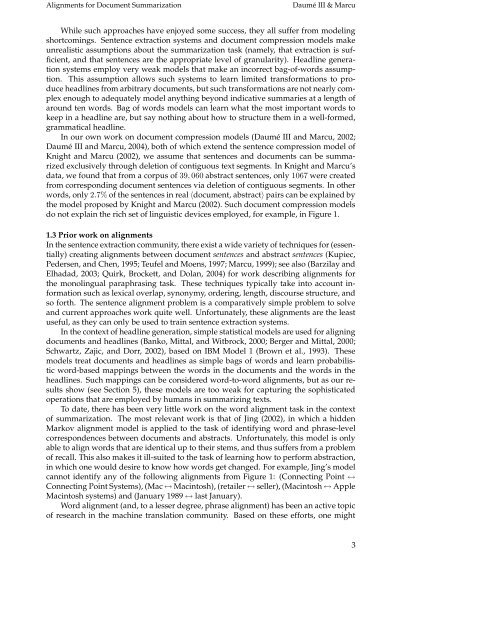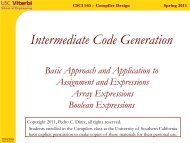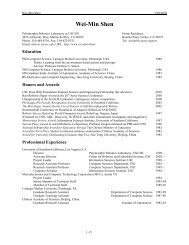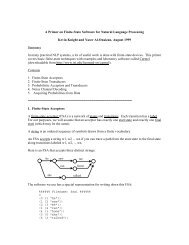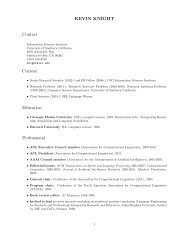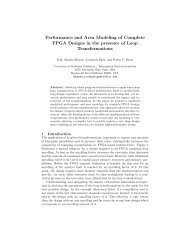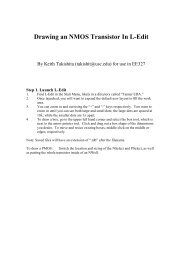Induction of Word and Phrase Alignments for Automatic Document ...
Induction of Word and Phrase Alignments for Automatic Document ...
Induction of Word and Phrase Alignments for Automatic Document ...
Create successful ePaper yourself
Turn your PDF publications into a flip-book with our unique Google optimized e-Paper software.
<strong>Alignments</strong> <strong>for</strong> <strong>Document</strong> Summarization Daumé III & Marcu<br />
While such approaches have enjoyed some success, they all suffer from modeling<br />
shortcomings. Sentence extraction systems <strong>and</strong> document compression models make<br />
unrealistic assumptions about the summarization task (namely, that extraction is sufficient,<br />
<strong>and</strong> that sentences are the appropriate level <strong>of</strong> granularity). Headline generation<br />
systems employ very weak models that make an incorrect bag-<strong>of</strong>-words assumption.<br />
This assumption allows such systems to learn limited trans<strong>for</strong>mations to produce<br />
headlines from arbitrary documents, but such trans<strong>for</strong>mations are not nearly complex<br />
enough to adequately model anything beyond indicative summaries at a length <strong>of</strong><br />
around ten words. Bag <strong>of</strong> words models can learn what the most important words to<br />
keep in a headline are, but say nothing about how to structure them in a well-<strong>for</strong>med,<br />
grammatical headline.<br />
In our own work on document compression models (Daumé III <strong>and</strong> Marcu, 2002;<br />
Daumé III <strong>and</strong> Marcu, 2004), both <strong>of</strong> which extend the sentence compression model <strong>of</strong><br />
Knight <strong>and</strong> Marcu (2002), we assume that sentences <strong>and</strong> documents can be summarized<br />
exclusively through deletion <strong>of</strong> contiguous text segments. In Knight <strong>and</strong> Marcu’s<br />
data, we found that from a corpus <strong>of</strong> 39, 060 abstract sentences, only 1067 were created<br />
from corresponding document sentences via deletion <strong>of</strong> contiguous segments. In other<br />
words, only 2.7% <strong>of</strong> the sentences in real 〈document, abstract〉 pairs can be explained by<br />
the model proposed by Knight <strong>and</strong> Marcu (2002). Such document compression models<br />
do not explain the rich set <strong>of</strong> linguistic devices employed, <strong>for</strong> example, in Figure 1.<br />
1.3 Prior work on alignments<br />
In the sentence extraction community, there exist a wide variety <strong>of</strong> techniques <strong>for</strong> (essentially)<br />
creating alignments between document sentences <strong>and</strong> abstract sentences (Kupiec,<br />
Pedersen, <strong>and</strong> Chen, 1995; Teufel <strong>and</strong> Moens, 1997; Marcu, 1999); see also (Barzilay <strong>and</strong><br />
Elhadad, 2003; Quirk, Brockett, <strong>and</strong> Dolan, 2004) <strong>for</strong> work describing alignments <strong>for</strong><br />
the monolingual paraphrasing task. These techniques typically take into account in<strong>for</strong>mation<br />
such as lexical overlap, synonymy, ordering, length, discourse structure, <strong>and</strong><br />
so <strong>for</strong>th. The sentence alignment problem is a comparatively simple problem to solve<br />
<strong>and</strong> current approaches work quite well. Un<strong>for</strong>tunately, these alignments are the least<br />
useful, as they can only be used to train sentence extraction systems.<br />
In the context <strong>of</strong> headline generation, simple statistical models are used <strong>for</strong> aligning<br />
documents <strong>and</strong> headlines (Banko, Mittal, <strong>and</strong> Witbrock, 2000; Berger <strong>and</strong> Mittal, 2000;<br />
Schwartz, Zajic, <strong>and</strong> Dorr, 2002), based on IBM Model 1 (Brown et al., 1993). These<br />
models treat documents <strong>and</strong> headlines as simple bags <strong>of</strong> words <strong>and</strong> learn probabilistic<br />
word-based mappings between the words in the documents <strong>and</strong> the words in the<br />
headlines. Such mappings can be considered word-to-word alignments, but as our results<br />
show (see Section 5), these models are too weak <strong>for</strong> capturing the sophisticated<br />
operations that are employed by humans in summarizing texts.<br />
To date, there has been very little work on the word alignment task in the context<br />
<strong>of</strong> summarization. The most relevant work is that <strong>of</strong> Jing (2002), in which a hidden<br />
Markov alignment model is applied to the task <strong>of</strong> identifying word <strong>and</strong> phrase-level<br />
correspondences between documents <strong>and</strong> abstracts. Un<strong>for</strong>tunately, this model is only<br />
able to align words that are identical up to their stems, <strong>and</strong> thus suffers from a problem<br />
<strong>of</strong> recall. This also makes it ill-suited to the task <strong>of</strong> learning how to per<strong>for</strong>m abstraction,<br />
in which one would desire to know how words get changed. For example, Jing’s model<br />
cannot identify any <strong>of</strong> the following alignments from Figure 1: (Connecting Point ↔<br />
Connecting Point Systems), (Mac ↔ Macintosh), (retailer ↔ seller), (Macintosh ↔ Apple<br />
Macintosh systems) <strong>and</strong> (January 1989 ↔ last January).<br />
<strong>Word</strong> alignment (<strong>and</strong>, to a lesser degree, phrase alignment) has been an active topic<br />
<strong>of</strong> research in the machine translation community. Based on these ef<strong>for</strong>ts, one might<br />
3


